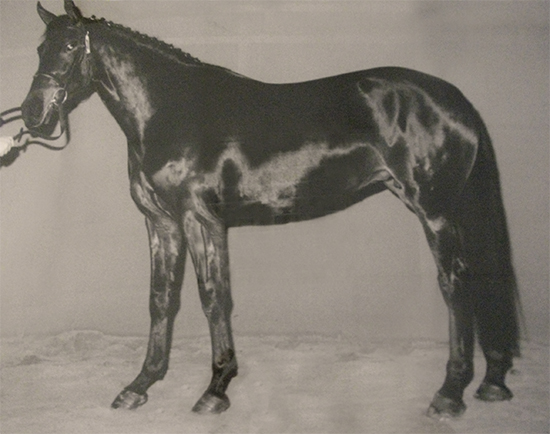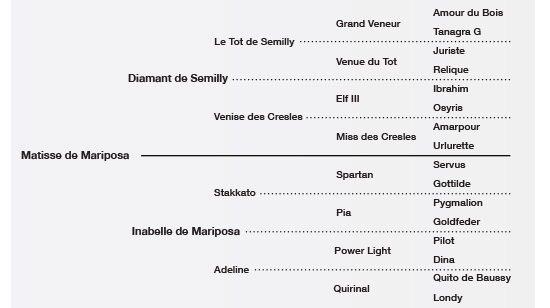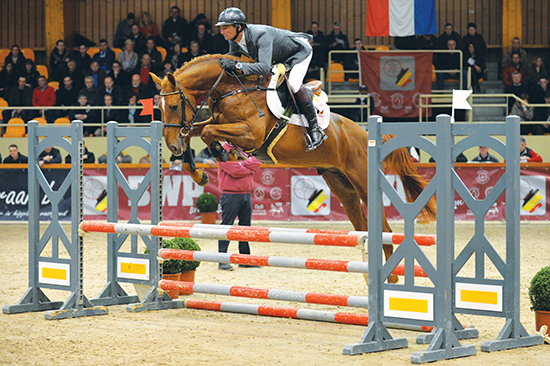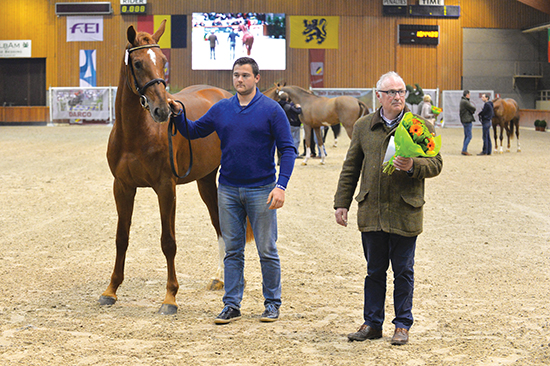 Words by Christopher Hector
Words by Christopher Hector
If there were an award – and no doubt there should be – for the leading breeder of showjumpers at the European championships, there is no doubt that the award would go to the Belgian breeder, Herman de Brabander. Last year at Aachen, it was Herman’s cousin, Joris who had four horses he bred in the Nations Cup. This year it was Herman, with two of his breeding in the limelight: Flora de Mariposa who finished fourth with Penelope Leprevost and Cantinero who finished 19th with Henrik von Eckermann.
Flora is by For Pleasure, out of Adeline, who is by the Pilot son, Power Light, out of Quirinal by Quito de Baussy out of Herman’s foundation mare, Londy. Cantinero who should rightly be called Chopin de Mariposa, is by Cento, out of Trezebees (by the Cor de la Bryère son, Cash) out of Quirinal.
Herman is a modest man, and it takes quite some persuasion from Belgian breeding enthusiast and bloodlines authority, Huub van Aert, to get him to come down from his seat in the Aachen stand for this little interview:
How did you start breeding horses, was it in your family?
“My family bred horses before me. My grandfather had horses, Thoroughbreds, ours is a horse family. I started with a daughter of Primo de Bruyéres, and then I built up my mares from this one foundation mare.”
 Herman’s foundation mare, Londy
Herman’s foundation mare, Londy
That mare was the French bred Londy. Primo de Bruyéres is by the French Thoroughbred, Night and Day, his dam Gazelle d’Aubry carries the blood of two of the great French Sporthorse Thoroughbreds, Fra Diavolo and Furioso. Londy’s dam, Ededee, carries the blood of three influential Hanoverians: Lugano van la Roche (a grandson of the great Thoroughbred, Der Löwe), Flügel van la Roche and Senator, through his son, Sturmwind van la Roche.
“I have used Holstein and Hanoverian stallions, but the base is French.”
What stallions do you use now?
“All origins, but they must jump, that is the final point. Every couple of years I have a stallion at the licensing. Last year, my stallion Matisse de Mariposa, was the reserve champion stallion. Matisse is from the same mother line as Flora and Cantinero. He is by Diamant de Sémilly out of Inabelle de Mariposa, by Stakkato, and out of Adeline, the mother of Flora.”
How many mares do you have?
“I have only three horses, the other ones I have given to my younger son. I have retired, my son goes on with the horses.”
Why are horses important to you?
“They are everything to me,” he says looking out onto the famous Aachener showground. “When they jump at this level – that’s it.”
When he became BWP Breeder of the Year 2014, there were tears in Herman’s eyes. There are breeders, and there are breeders who breed with passion…
Aachen wasn’t just a triumph for Mr de Brabander, but also for the BWP studbook itself. Ninety-four horses started in the first round speed class. There were 5 Westfaliens, 7 from Oldenburg (plus one Oldenburg Jumping), 9 Selle Français, 12 Holsteiners, 12 KWPN, and a staggering 15 from the BWP in little Belgium, with just 3000 mares.
 Mattise de Mariposa. Photo: Peter Van den Bulck
Mattise de Mariposa. Photo: Peter Van den Bulck
Huub van Aert took time out talk about the BWP bloodlines…
“Warmblood breeding began in the 1950’s, but they had good heavy blood from The Netherlands, the Gelder horses and also the Belgian farm horses – they worked on the land so they liked to work, if they didn’t work, they went away. That’s still important today, that the horse wants to work, a mentality to work.”
“On the Sunday, the children of the farmers, they liked to go to the competitions and do something more with the horses, but it started really from the farmers. We are a small country, so we looked for horses from everywhere. Other studbooks were closed, but in Belgium there were some very powerful stallion keepers, who had a good eye and went abroad to look for stallions.”
“For example Marcel van Dyck from Broechem. He is now retired, his son Joris took over – he brought in from France, Muscaris D’Ariel, who jumped at the World Equestrian Games in Kentucky. Also Marcel van Dyck had the stallions Quintus and Tresor d’Opaline, which jumped at the Olympic Games. There was also Louis Lenaerts from Kieldrecht, and he brought in Lys de Darmen which is now in many of the mother lines, for example Action Breaker, Valentina van ‘t Heike, Ninja la Silla. His daughter Kaat Lenaerts, who is married to Luc Tilleman, went further with the farm and they are also very successful with the stallion Toulon. Those are just a few examples of stallion keepers who looked abroad.”
The most important stallion was Darco?
“Darco is of course an important stallion, but I think also Heartbreaker, Lys de Damen, Skippy also. That’s the strongest thing, it was not only Darco, he crossed well with Heartbreaker, so you got some blood from Heartbreaker.”
“However the best stallion of the BWP studbook is of course Cornet Obolensky who was first called, Windows van ‘t Costerveld. In the BWP studbook stallions can obtain the label ‘Ambassadeur’. Cornet was born in the BWP and has become an Ambassador. To become an ambassador of the BWP studbook is not easy: The stallion needs to jump in the Olympic finals, or one of its progeny needs to jump in the Olympic finals or they need to have at least five products in the WBFSH ranking list. Furthermore the stallion needs to be in the top 100 of the WBFSH stallion ranking. Other examples of ambassadors are Carembar de Muze who is now called London, Nabab de Rêve, Tangelo van de Zuuthoeve, Toulon and Vigo d’Arsouilles.”
“It was important in Belgium that the horses were healthy, because they had to work on the land. Now within the studbook, they look closely at the x-rays and they have a very strong selection criteria, so when there is a problem with the x-rays, the horse does not go on to breed. Compared to the German studbooks, they looked more to how high they can jump but not so much to the health issues – and now they sometimes have problems. In the Belgian studbook they looked right from the start to the health of the horse.”
“Since it is a small country, the breeders still look abroad to the best stallions, the studbook is not closed and they accept the outside bloodlines. Of course, if you use a stallion from outside the book, then you pay a little more to register the foal.”
“If you go to the results, the BWP is just a small studbook, but in the studbook rankings, we are very high even with only 3000 foals each year. What they should do in the studbook rankings is look to the number of foals born, and correct for that. In the WBFSH I think it would be better if the studbooks would work together and release the number of foals born each year to the stallions. Then you would know how many Darcos there are in Holstein, in Hanover, in KWPN, and then you would get a real idea which stallion is a good stallion. This would be good for the breeders, and that is who should be taken care of, because it starts with the breeders. At the moment the breeders have to find out the information themselves.”
“That’s why I go everywhere, to Germany, to France, to The Netherlands. I go everywhere to watch horses and learn. But there are a lot of people who do not do this, and it would be good to give them the knowledge by bringing the information together through the WBFSH.”
“In the BWP it is also an advantage that the horses keep their birth name. For example at the KWPN, when a foreign stallion is approved, its name needs to be changed. The champion Grand Slam VDL is the BWP stallion Lucky Won van het Bevrijdthof (v. Cardento x Heartbreaker). Out of the same mother another stallion was approved Dallas VDL (v. Douglas) – also by birth Indouglas van het bevrijdthof. One should give more credits to the breeder and not change the birth name.”
“In Belgium, the breeding scene is also strong because it is not so professional, it is more like they do it for free, with a lot of volunteers. I am also a volunteer and that makes us strong, because you are not working to make a lot of money, it is just for fun, and that you love your horses – not to make money with the horses. The BWP is not always asking the breeders for money, they listen to the breeders, and I think other studbooks could learn from that – listen more to the breeders.”
“I was in the BWP Promotions Team last year, but that was re-organized, and there is no team any more. It is done nationally now, but I am involved in that. The breeding is divided in different provinces, I am from the Province of Antwerp, a very big province with a lot of horses, and I do promotion there for the BWP horses.”
“I have a lot of friends there. That is important, horse breeding brings people together as friends.”
I myself have five horses. Four mares and one filly. Next year I hope for four foals, two from one mare, a Cornet Obolensky, one from an Orame (v. Indoctro x Ramiro) mare, one from a KWPN mare by Holland (v. Concorde x Nimmerdor) but now in BWP – from her I get a Taran de la Pomme. From the Cornet Obolensky, I hope to get a Tangelo vd Zuuthoeve, and an Arezzo VDL. The foals out of the Cornet mare are embryo transplants. The Cornet mare was recently sold to Joris de Wachter, who has sold it now already to Max Hauri Pferde in Switzerland.”
“My stallion is two years old, he is a Muscaris D’Ariel (v. Diamant de Semilly x Laudanum) out of the Holland mare. Possibly he will go to the stallion show next winter.”
Matisse de Mariposa and his proud breeder, Herman de Brander. Photo: Peter Van den Bulck
What are the most popular stallions for the BWP breeders?
“The ambassadors Nabab de Rêve and also Tangelo vd Zuuthoeve are popular. Also Cicero van Paemel and Toulon, are very good stallions. Thunder vd Zuuthoeve is also a very good stallion, but unfortunately recently died. Of course also Cornet Obolensky is quite popular.”
In all the European studbooks, the numbers of mares being bred, foals being born, is down, is it the same in Belgium?
“In Belgium, it is up. In the BWP this year, we had more foals than the year before, it’s going up. Last year it was up on the year before, and the same the year before that. I think nowadays people know that the BWP horses are good horses, they jump very well internationally and everyone sees this. The breeders think, it’s a good label on my horse, to have a BWP brand. We get a lot of foreign breeders coming to the BWP who went in the past to the KWPN. They see the BWP is a very good studbook and that brings more breeders to Belgium.”

